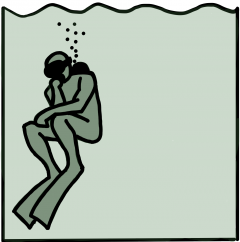Since there was a question on Scuba Board about how to compute the tissue pressures when diving a CCR (i.e mainlining constant partial pressure of oxygen) when changing depth at a constant rate. When putting this on a computer I would say doing it for small time steps and pretending to be at constant depth for that short amount of time doesn’t do much wrong and you will end up doing this anyway (at least that’s what we do in Subsurface). But for the fun of it, let’s work out the analytic solution.
Let’s start by figuring out the inert gas ambient pressure at a given depth. We call \(p_d\) the diluent partial pressure, \(p_{O2}\) the partial pressure supplied from the oxygen cylinder (note that this is not the oxygen partial pressure since there is going to be some oxygen in the diluent as well), \(d\) is the depth, \(f_{O2}\) is the fraction of oxygen in the diluent while \(f_i\) is the fraction of the inert gas we are computing in the diluent.
There are two obvious equations: The ambient pressure is equal to the diluent pressure plus the oxygen pressure in the loop:
$$ p_d + p_{O2} = p_a = p_{surf} + dg\rho$$
Here, \(p_{surf}\) is the surface pressure, and \(\rho\) is the density of water and thus \(g\rho\) the conversion factor between depth and pressure. The second equation says that the total partial pressure of oxygen (from diluent and oxygen cylinder combined) has to equal the set point pressure \(p_s\):
$$f_{O2} p_d + p_{O2} = p_s.$$
We can subtract both equations to eliminate \(p_{O2}\) and find
$$ p_d = \frac{p_{surf} + g\rho d -p_s}{1-f_{O2}}.$$
This goes into the usual diffusion equation for the inert gas loading in the tissue \(p_t\) that we are ultimately interested in:
$$\dot p_t = -\gamma( p_t -f_i p_d).$$
\(\gamma\) is the usual diffusion constant that is related to the inverse of the tissue half-time by a factor of \(\ln(2)\). Finally, we want the depth to change linearly in time, so \(d=d_0+vt\) where my sign convention is that \(v\) is the descend velocity, make it negative for ascends.
So we have to solve a linear inhomogeneous ODE with constant coefficients which we could tackle by “varying the constants”, but of course we are lazy and let Mathematica do the job. After a bit of massaging, we find
$$p_t = \frac{f_i}{1-f_{O2}} \left( e^{-\gamma t} -1\right) \left( p_s + \frac{vg\rho}\gamma\right) + e^{-\gamma t}\left( p_0 – \frac{f_i}{1-f_{O2}} (p_{surf} + d_0g\rho)\right) + \frac{f_i}{1-f_{O2}}(p_{surf} + dg\rho)$$
where \(p_0\) is the initial tissue loading. So, here you go this is the CCR Schreiner equation. Or, if you want to follow the tradition to attaching names to simple solutions of ODEs, I allow you to call it the Helling equation.
Update: If you are worried that a constant water vapour pressure has not been taken into account, you can bring it in by replacing the set point by the actual set point plus the water vapour pressure in all equations above.


To be completely right you should add the acceleration g for the link between depth and pressure.
Nevertheless: Great blog 🙂
Thanks. Replaced [latex]\rho[/latex] by [latex]g\rho[/latex] everywhere.
I believe your first, obvious, equation may be incorrect since the loop is saturated in water vapour at a constant partial pressure of around 47mmHg which should probably be taken into account. As a practical matter, I’m not really sure how much of a difference this discrepancy would make though.
I added a comment on how to take care of the water vapour.
Nice. It’s probably glaringly obvious to readers with the sophistication required to understand the derivation, but it might be worth pointing out that the Helling equation applies to dive segments with constant Oxygen partial pressure, so care should be taken to decompose segments with a starting or ending ambient pressure below the setpoint.